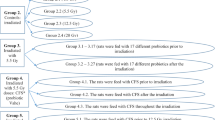Abstract
Lethally irradiated conventional mice were killed at daily intervals after irradiation. A high correlation was found between the occurrence of bacterial over-growth in the digestive tract and invasion into the regional lymph nodes the spleen and the blood. By oral contamination of mice with quite high doses of either an exogenous or an endogenous biotype of an Enterobacteriaceae species at day 4 after irradiation, it was attempted to induce such condition of intestinal over-growth. In all animals such an abnormal colonization of the contaminant was indeed achieved in this way and the mice died from an infection caused by the biotype used for the contamination.
The interval between contamination and death was different when different biotypes were used for contamination and occurred sooner after irradiation when an endogenous biotype was used for (re)contamination. It is concluded that oral contamination with exogenous as well as with endogenous potentially pathogenic bacteria during a period of severely decreased resistance to infections must be avoided. The colonization resistance of the digestive tract of these animals should be maintained as high as possible.
Similar content being viewed by others
References
Abrams, G. D. and Bishop, J. E. 1966. Effect of the normal microbial flora on the resistance of the small intestine to infection. — J. Bacteriol. 92: 1604–1608.
Gongdon, C. C., Williams, F. P., Haberman, R. T. and Lorenz, E. 1955. The histpathology of bacterial infection in irradiated mice. — J. Nat. Cancer. Inst. 15: 855–859.
Gordon, L. E., Ruhml, D., Hahne, H. J. and Miller, P. 1955. Studies on susceptibility to infection following ionizing irradiation. — J. Exp. Med. 102: 413–423.
Kent, T. H., Osborne, J. W. and Wende, C. M. 1968. Intestinal flora in whole-body and intestinal X-irradiated rats. — Rad. Res. 35: 635–651.
Klainer, A. S., Gorbach, S. and Weinstein, C. M. 1967. Studies of intestinal microflora. IV. Effect of X-irradiation on the fecal microflora of the rat. — J. Bacterol. 94: 378–382.
Livestone, E. M., Spiro, H., Hersh, T. and Floch, M. H. 1970. The gastrointestinal microflora of irradiated mice. — Yale J. Biol. Med. 42: 439–447.
Myerowitz, R. L., Medeiros, A. A. and O'Brien, T. F. 1971. Recent experience with bacillemia due to gram-negative organisms. — J. Inf. Dis. 124: 239–246.
Smith, W. W., Alderman, I. M., Schneider, C. A. and Cornfield, J. 1962. Radiation dose-response characteristics of leukocytes in the mouse. — Proc. Soc. Exp. Biol. Med. 111: 182–187.
Sneath, P. H. A. 1956. Cultural and biological characteristics of the genus Chromobacterium. — J. Gen. Microbiol. 15: 70–98.
Van der Waaij, D. and Sturm, C. A. 1968. Antibiotic decontamination of the digestive tract of mice. Technical procedures. — Lab. Anim. Care 18: 1–10.
van Der Waaij, D., Berghuis-de Vries, J. M. and Lekkerkerk-van der Wees, J. E. C. 1971a. Colonization Resistance of the digestive tract in conventional and antibiotic-treated mice. — J. of Hyg. 69: 405–413.
Van der Waaij, D. and Andreas, A. H. 1971b. Prevention of airborne contamination and cross-contamination in germ-free mice by laminar flow. — J. Hyg. 69: 83–89.
Van der Waaij, D., Berghuis, J. M. and Lekkerkerk, J. E. C. 1972. Colonization resistance of the digestive tract and the occurrence of spread of bacteria to lymphatic organs in mice. — J. of Hyg. 70: 55–60.
Van der Waaij, D., Cohen, B. J. and Nace, G. W. 1974a. Colonization patterns of aerobic gramnegative bacteria in the cloaca of Rana pipiens. — Lab. Anim. Sci. 24: 307–317.
Van der Waaij, D. and Berghuis, J. M. 1974b. Determination of the colonization resistance of the digestive tract of individual mice. — J. Hyg. 72: 379–387.
Watson, J. R. and Hammond, C. W. 1967. Incidence of endogenous bacterial infection in murine radiation chimeras with secondary diseases. — Rad. Res. 32: 581–586.
Author information
Authors and Affiliations
Rights and permissions
About this article
Cite this article
van der Waaij, D., Tieleman-Speltie, T.M. & De Roeck-Houben, A.M.J. Relation between the faecal concentration of various potentially pathogenic microorganisms and infections in individuals (mice) with severely decreased resistance to infection. Antonie van Leeuwenhoek 44, 395–405 (1978). https://doi.org/10.1007/BF00394316
Received:
Issue Date:
DOI: https://doi.org/10.1007/BF00394316




